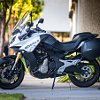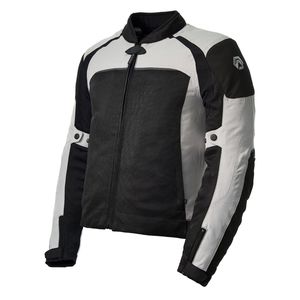If you’re in the market for a new middleweight sport-touring motorcycle that won’t break the bank, your options have recently increased from just one to three.
With the arrival of the $9,495 Triumph Tiger Sport 660 and the remarkably inexpensive $6,799 CFMOTO 650 ADVentura, the $9,999 Kawasaki Versys 650 LT, which has only ever had the Suzuki V-Strom 650 to pester it and stood largely uncontested for over a decade, finally has some real competition. How does the new Tiger Sport 660 compare to the stalwart Versys, and can the upstart ADVentura hold a candle to — or perhaps even outshine — the Kawasaki and Triumph?

These new-for-’22 motorcycles have individually appeared on Common Tread before (see “Related Stories”), but nothing reveals the differences between bikes better than riding them back-to-back. So we gathered the three machines in the RevZilla West garage and I assembled a crack team of testers: Zack Courts, whose Daily Rider exploits give him a better perspective on current bikes than anyone I know, and Common Tread Journal’s editor (and former editor-in-chief at Motorcyclist magazine, where he held dominion over both myself and Zack) Marc Cook, whose experience in the realm of vehicle analysis extends from motorcycles to experimental aircraft.
I’d put the old band back together, and our reunion tour was all about establishing a hierarchy for this new era of affordable sport-tourers.
Meet the contenders
Since it came across the Pacific in 2008, Kawasaki’s Versys 650 has served as a benchmark for affordable two-wheeled versatility. “Capable, comfortable, unassuming. Universally good,” summarizes Marc, a former second-gen V-650 owner. The Kawasaki’s modest price, decent touring chops, unexpectedly sporty handling, truly excellent luggage, and economic (if not exciting) 65-ish horsepower 649 cc parallel-twin engine have made it a favorite among pragmatic riders. For 2022 the Versys 650 LT received its fourth update, which saw modernizing features like all-new styling, a TFT dash, three-level traction control, and all-LED lighting.
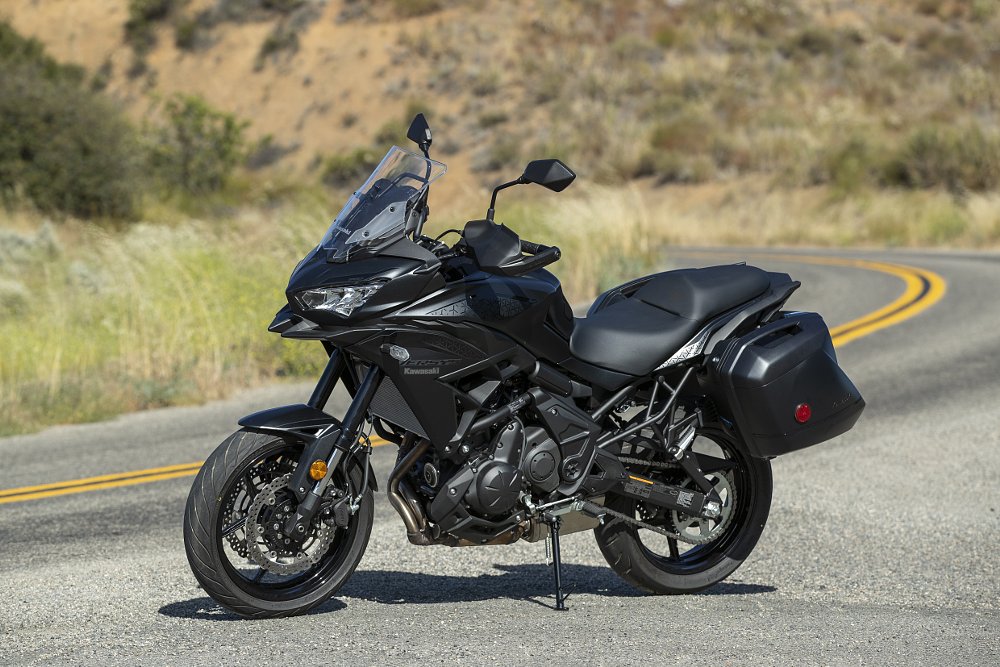
Entering the ring from across the Atlantic, Triumph’s Tiger Sport 660 takes aim at the Versys with the 80 (claimed) horsepower inline-triple from the Trident roadster slotted into a slender, stiffer sport-touring package. “It’s similar to the Kawasaki,” says Zack, “but with less body fat; it’s more athletic.” It has a tidy LCD/TFT display, easily adjustable windscreen, traction control, ABS, LED lighting, and remotely adjustable shock preload like the Versys, but otherwise the Tiger Sport 660 is a no-frills performer. Tacking $585 onto the $9,495 base price gets you hard bags and puts the Tiger Sport 660 within spitting distance of the Kawasaki in terms of price and cargo capacity.
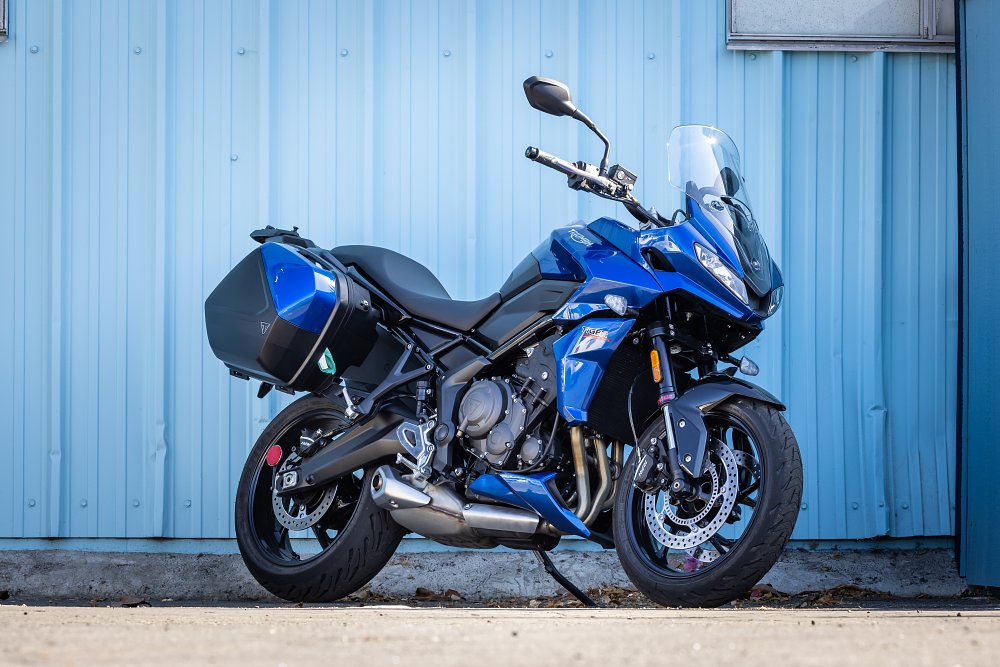
Arriving from Hangzhou, China, the 650 ADVentura is a new model for CFMOTO’s 200 or so American motorcycle dealers, and appears designed to dethrone the Versys 650 by way of imitation and improvement.

The engine and general underpinnings of the ADVentura are clear knockoffs of the Versys, from the cylinder casting to the style and bolt spacing of the rear sprocket. However, CFMOTO has upped the ante with a larger and more feature-rich five-inch TFT dash, stainless-steel brake lines, upspec Pirelli tires, and most importantly, a $6,799 MSRP, and that includes the SHAD panniers. That price is $100 less than the original Versys cost — 14 years ago! The ADVentura is a full-featured machine, and on paper, it matches or outdoes the other two bikes in just about every aspect except horsepower and curb weight.
Welcome to the cheap seats
The Versys may be our benchmark, but that doesn’t mean it has the perfect rider triangle. We’ve always felt the V-650 was a little shy on legroom, and the seat, while well contoured, can feel too soft at the end of an especially long day. At 33.3 inches high, the saddle can also be too tall for riders under the five-foot-nine mark. Marc and I both noted that the previous generation’s windscreen and fairing offered better aero, but we all appreciated the more convenient height-adjustment lever that replaces the previous gen’s two threaded knobs.
Compared to the CFMOTO and especially the 7/8th-scale Triumph, the Kawasaki presents as large; wider between your knees and heavier, even if its 503-pound wet weight undercuts the ADVentura by 14 pounds. Part of the Kawasaki’s perceived girth surely comes from its large 5.5-gallon tank. It’s a boon for range, but certainly contributes to a sense of bulk, especially when full.
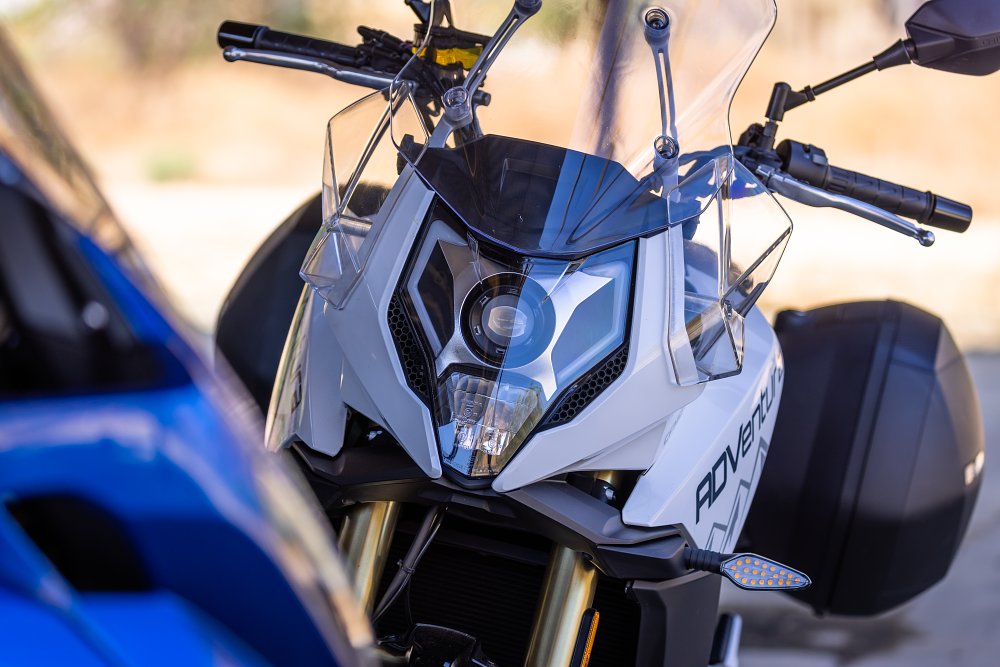
Despite being the heaviest bike here, CFMOTO’s 650 feels smaller and lighter than the Versys. “It’s compact, and feels narrow,” reports Zack. The 33.0-inch-high seat also scored well with our group; nicely shaped and detailed, with firmer foam than the Kawasaki. Everyone knocked the windscreen adjustment, though, which uses difficult-to-reach knobs and cast-aluminum slides that shed paint and can get cocked in their tracks if you aren’t careful. Wind protection is decent, but none of us ever felt like we were sitting in a calm pocket of air. The footpegs threw us off, too. They’re set too wide and too far forward, which also makes them feel high.
“I found myself in the ‘Sportser stance’ at stops,” reports Marc, meaning he set his feet down behind the pegs, rather than in front of them as on the Versys and Tiger Sport 660.

If the CFMOTO has some awkward features, the Triumph is well thought out and executed, and incredibly neat. The raw-aluminum footpegs are under your butt where they belong, the ‘bar is wide, and even though the narrower, thinner seat is a half inch lower than the Kawasaki’s perch, you get an extra half inch of legroom. “It feels like you’re up on top of the bike,” says Zack, “as opposed to the Versys where you sit ‘in’ it.” The riding position is a little sportier on the Tiger, but it’s still upright and comfortable, and enhanced by an adjustable windscreen that’s so easy to use it “puts the other two to shame,” says Zack. You can operate it with one hand, while riding, and since the screen follows an arc and is more vertical when raised, adjusting the height feels especially effective.
Throttling up
Engine character is a focal point for most bikes, but not so much for the Kawasaki. The parallel twin is efficient and fun, with a strong midrange and a spirited rush above 6,500 rpm, but the sound and feel are about as dull as they come. On top of that, some unlucky Versys get clunky gearboxes (our test bike, and my personal 2015 LT, are among them), and they all suffer from somewhat abrupt throttle response.

CFMOTO emulated Kawasaki pretty well on the engine front, all the way down to the long-throw, numb-feeling transmission and shoddy fueling. The ADVentura even adds a pronounced hiccup at about 3,200 rpm and, despite making less power (as per the specs, our seat-of-the-pants impressions, and more than a few full-throttle drag races), CFMOTO’s engine kicks off more heat than the Kawasaki. A lot more.
The Triumph is guilty of excess engine heat, too, along with a borderline-annoying amount of high-frequency vibration in the grips and footpegs at highway speeds. And while the Triumph supposedly makes 30% more power than the Versys and weighs 22 pounds less according to our scales, at wide open the Kawasaki keeps pace with the Triumph up to about 110 miles per hour. Doing more with less is the V-650’s forte.
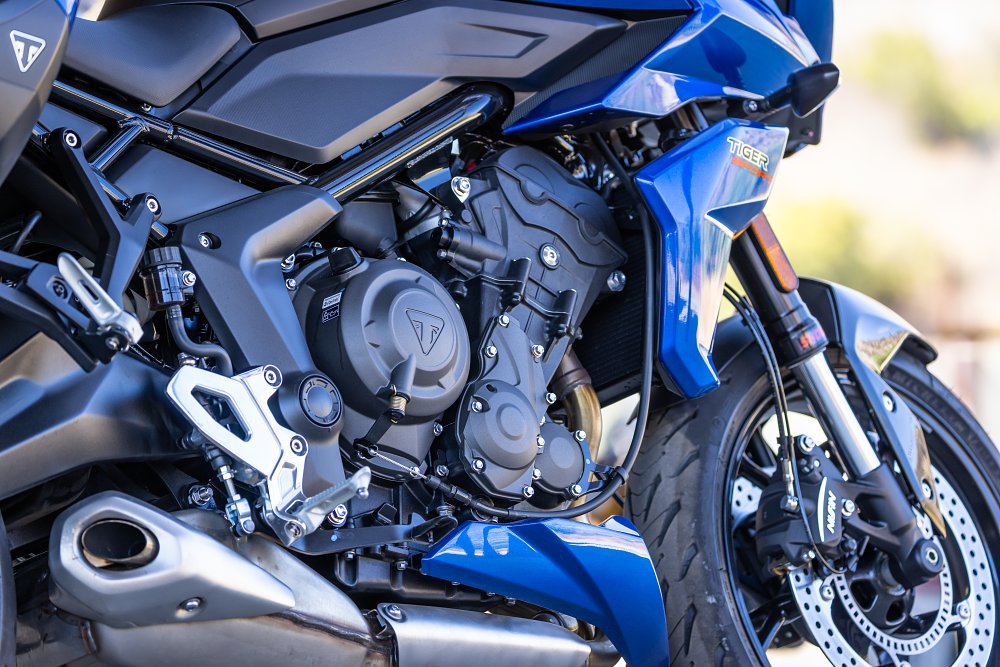
Even if the 660 motor isn’t as powerful or smooth as we’d like, it’s still a sweet and characterful engine, and certainly feels more refined and sportier than the more workaday twins. “Excellent throttle response, nice gearbox, smooth and predictable clutch, not much driveline lash. A typically well refined Triumph,” read Marc’s notes.
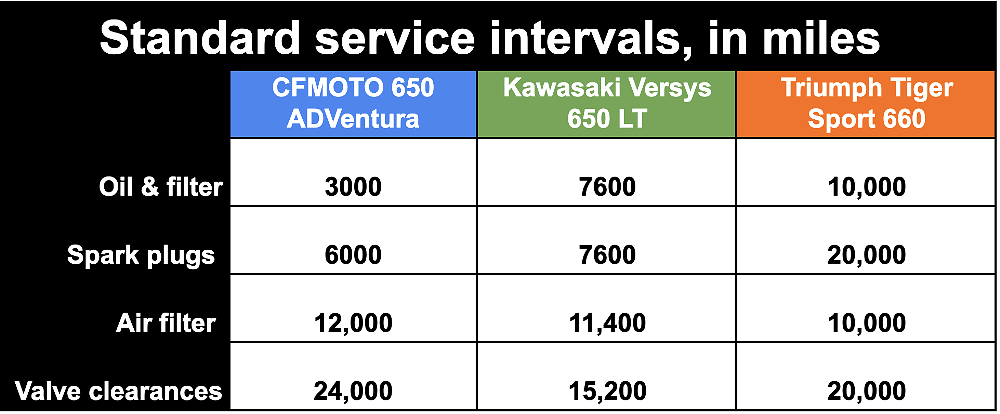
As you might expect, these mildly tuned middleweight engines are all fairly efficient. The 650 ADVentura, Versys 650, and Tiger Sport 660 averaged 49.1, 47.6, and 46.7 miles per gallon, respectively. That gives the Triumph a range of about 200 miles with its 4.5-gallon tank, while the CFMoto can cover approximately 230 miles with its 4.7-gallon payload, and the Versys has been shown to reliably cover 250 miles between fill ups.
Twists and turns
When it comes to ride quality and handling, the Versys once again sets a high bar. “I can get on this bike after a long period away and feel immediately at home, confident, comfortable,” says Marc. “It’s a little squishy and underdamped,” says our heaviest rider, 200-pound Zack, “but man, when it settles on the side of the tire it just feels happy.” The quickness with which the Versys turns, its stability at lean, and its willingness to tighten or adjust a line have always impressed even the most experienced riders.
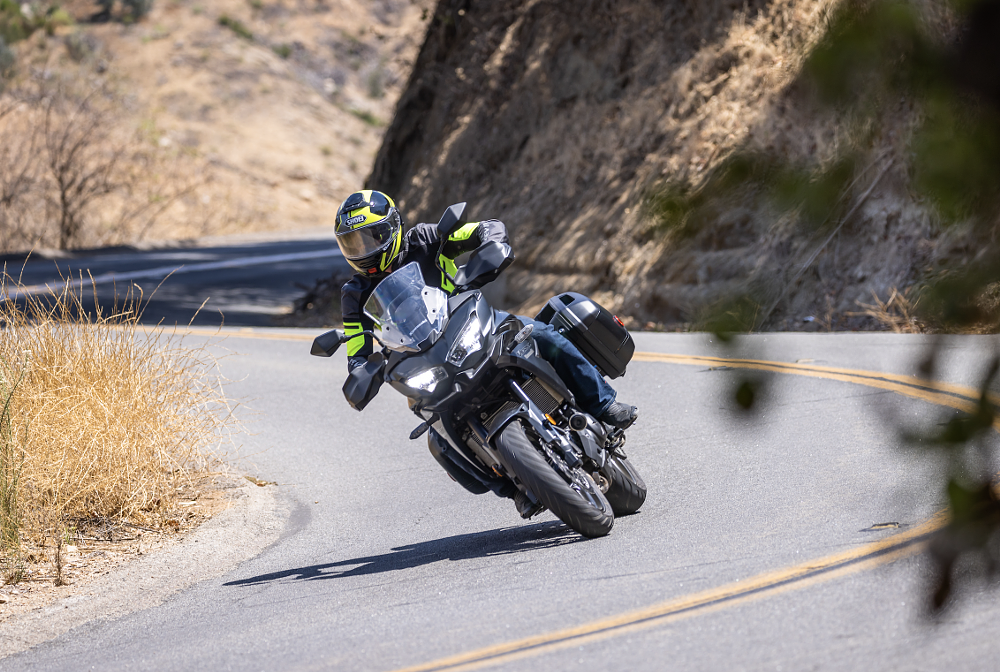
The Kawasaki’s Showa suspension isn’t very sophisticated, but it’s well set up and doesn’t have to contend with huge power or fierce brakes, so isn’t easily flustered. The hand-operated hydraulic preload adjuster makes it easy to add ride height to accommodate luggage or a passenger, and you can tune preload and rebound damping on the fork if you want. Triumph’s Tiger Sport 660 also comes with a hydraulic preload adjuster, but that’s your only tuning option, front or rear.
Luckily, the Tiger Sport 660’s Showa fork and shock are also well set up and exceptionally functional, though they’re definitely skewed tauter. That’s a good thing, as it enables the rider to take advantage of the bike’s aggressive steering geometry, lighter weight, and spunkier engine to really embrace the “sport” in “sport-touring.” The brakes don’t have particularly strong bite (I’d even call them soft), even with larger 310 mm rotors, but there’s plenty of power and feel once you get deeper into the lever stroke. The Tiger 660 Sport is certainly the quickest and most enjoyable bike on a twisty road. It even has a wider 180-section rear tire to advertise its sportiness, even if the engine’s power doesn’t warrant it.

Then, there’s the CFMOTO. I’d only ridden the bike a short distance on surface streets before I pulled over to type these notes in my phone: “Shock bottomed in intersection dip. Needs spring and compression damping, bad. Fork can be bottomed with a sharp stab of the brakes at low speed, yet feels noncompliant at high speed and skips over scabby pavement.” The shock is simply too soft, and the fork is an unfortunate combination of a too-soft spring rate and too much damping.
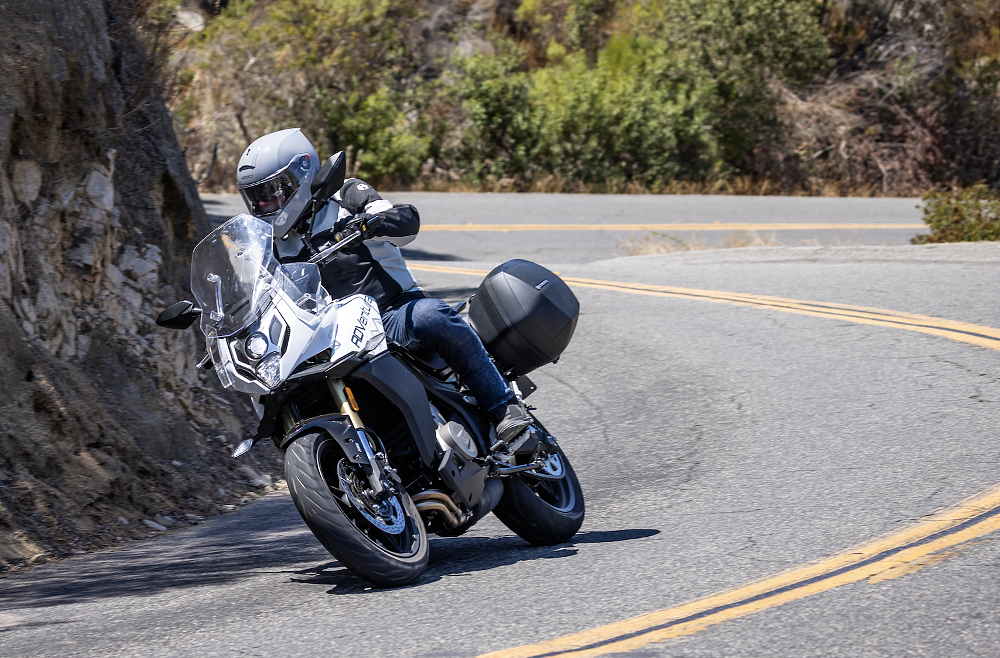
I added about 5 mm of shock preload (with my own spanner, since the 650 ADVentura’s toolkit doesn’t include the necessary tool for the conventional preload collars) and tightened the rebound damping by three clicks. Zack later took several clicks of damping out of the fork. To the credit of the ADVentura’s KYB suspension, the changes made a noticeable difference, but it wasn’t enough. With our adjustments the ride quality became decent in a straight line, but the chassis is poorly balanced and calibrated for sporty riding.
Tech and features
TFT dashes of varying size take center stage in all three cockpits. The CFMOTO’s is the biggest, and features an attractive (and adjustable) layout, though the font choice isn’t exactly easy to read. That’s a small gripe compared to the fact that the dash completely, entirely disappears in a sheet of glare if the sun is behind you. Many times I found myself positioning my helmet to cast a shadow on the screen in an effort to see anything. Neither of the other two bikes are particularly susceptible to glare, so it’s strange that the CFMOTO’s screen is so affected.

The Tiger Sport 660 uses the same dash as the Trident, with a half-moon LCD screen positioned above a postage-stamp of a color TFT display. It’s an odd layout, but our only real complaint here is that the clutch cable arcs across the lower screen, somewhat obscuring the rider’s view. Out of the three bikes, the new 4.3-inch display on the Versys is the easiest to read thanks to size, font style and size, and brightness.
The technology train continues with various apps that allow your smartphone to communicate with the bikes. Kawasaki offers the Rideology app, Triumph has the My Triumph app, and CFMOTO has its CFMOTO Ride app. All provide ride tracking with stats and a few other features, but only the CFMOTO Ride app has turn-by-turn navigation on screen. (You can enable navigation with the My Triumph app, but it requires a $230 “connectivity module” for the bike.) Zack delved into the CFMOTO Ride app for his Daily Rider review and reported that “there are no street names or map shown, so it’s simplistic, but it guides the rider nicely while still showing the speedo and other crucial info on the dash.”

All three bikes have ABS, and the ADVentura’s is lenient enough to let you bring the back tire off the ground. If you’re after traction control, only the Kawasaki and Triumph offer it, though it could be argued that none of these bikes actually warrant it.
If you need to stash two full-face helmets or a week’s worth of clothes, the side cases on any of these bikes will do it. CFMOTO collaborated with Shad to equip the ADVentura with SH36 cases that can be left unlocked and thus opened without the key — a huge plus in some testers’ views. We also liked the integrated shelf at the bottom of the bags, though the plastic strap that supports the lid regularly got in the way when closing the cases.
Triumph’s luggage system is slick and color-matched to the bike, but we still think Kawasaki’s KQR cases take the cake, even if you do need the key to open them. The latching system is robust and the Versys gets bonus points for looking good in the nude; when you take the panniers off the CFMOTO and Triumph, you’re left with unsightly brackets.
Is a new king crowned?
Rolling into this test, we figured the Tiger Sport 660 had a good shot at usurping the Versys for the budget-bike throne. In the end, though, the Kawasaki was able to resist the coup.
That said, we like the Triumph, and can certainly see it being a perfect fit for riders who prefer a smaller, lighter bike, or those who typically do more spirited short-range stints. As a touring bike, it takes a back seat to the Kawasaki due to its smaller tank, buzzier engine, stiffer suspension, and thinner seat.
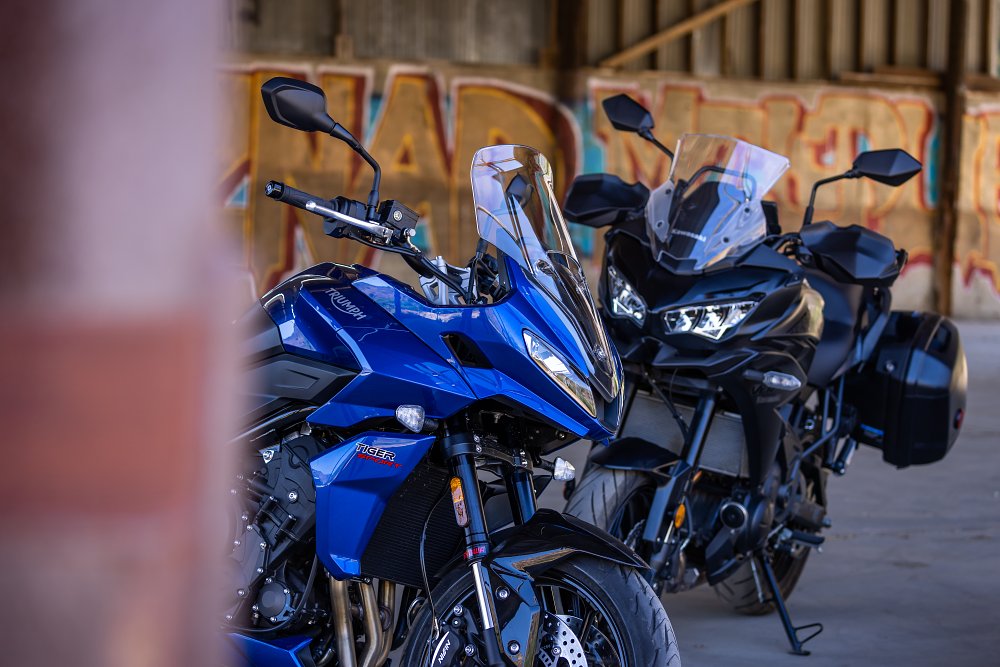
There’s no denying the CFMOTO offers a lot of features for not a lot of dollars. Regrettably, the bike isn’t as good as it looks on paper. “If you didn’t have the Versys there for direct comparison, it wouldn’t seem bad.” says Marc. Except we do have the Versys, and CFMOTO is so clearly imitating it, which demands a comparison. “It’s like a veggie burger,” says Zack. “Not inherently unsatisfying or ‘bad,’ but when you bite into it with an expectation of what you’ve had before, it’s hard not to be a little disappointed.”
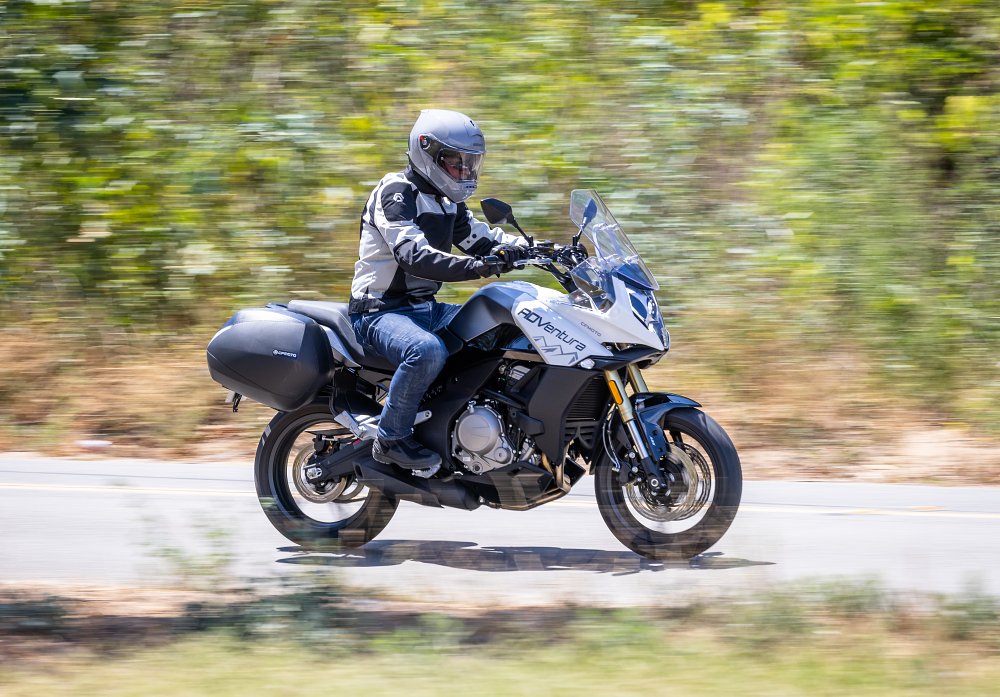
Disappointing function aside, our group also had concerns about reliability and parts viability. CFMOTO backs up its bikes with a 24-month warranty, and according to a buddy at a local dealership that sells CFMOTO ATVs, the vehicles are fairly reliable (no major mechanical failures) and parts usually arrive from CFMOTO’s warehouse in Kansas City in about a week. That’s encouraging and gives us hope for the future.
“Maybe not the next generation,” theorizes Marc, “but the one after that from CFMOTO could be very good. But there’s a long way to go.”
As it stands, “You simply can’t take the $6,800 CFMOTO and throw money at it to make it as good as the Versys is right out of the box,” states Marc.
He’s right, and if funds are really so short that a sub-$7000 bike is all you can afford, then just buy a used Versys. Because even with fresh competition, it’s still the best budget sport-tourer out there.
| 2022 CFMOTO 650 ADVentura | 2022 Kawasaki Versys 650 LT | 2022 Triumph Tiger Sport 660 | |
|---|---|---|---|
| Price (MSRP) | $6,799 | $9,999 | $9,495 ($10,080 as tested) |
| Engine | 649 cc, liquid-cooled, eight-valve, parallel twin | 649 cc, liquid-cooled, eight-valve, parallel twin | 660 cc, liquid-cooled, 12-valve triple |
|
Transmission, final drive |
Six-speed, chain | Six-speed, chain | Six-speed, chain |
| Claimed horsepower | 60.0 @ 8,750 rpm | NA | 80.0 @ 10,250 rpm |
| Claimed torque | 41.3 foot-pounds @ 7,000 rpm | 44.8 foot-pounds @ NA rpm | 47.0 foot-pounds @ 6,250 rpm |
| Frame | Steel-tube perimeter | Steel-tube perimeter | Steel-tube perimeter |
| Front suspension | KYB 43 mm fork adjustable for rebound damping, NA travel | Showa 42 mm fork adjustable for spring preload and rebound damping; 5.9 inches of travel |
Showa 41 mm fork; 5.9 inches of travel
|
| Rear suspension | KYB shock, adjustable for spring preload and rebound damping; NA travel | Showa shock, remotely adjustable for spring preload; 5.7 inches of travel | Showa shock, remotely adjustable for spring preload; 5.9 inches of travel |
| Front brake | Dual J.Juan two-piston calipers, 300 mm discs with ABS | Dual Nissin two-piston calipers, 300 mm discs with ABS | Dual Nissin two-piston calipers, 310 mm discs with ABS |
| Rear brake | J.Juan single-piston caliper, 240 mm disc with ABS | Nissin single-piston caliper, 250 mm disc with ABS | Nissin single-piston caliper, 225 mm disc with ABS |
| Rake, trail | 25.4 degrees, 4.06 inches | 25.0 degrees, 4.30 inches | 23.1 degrees, 3.80 inches |
| Wheelbase | 56.0 inches | 55.7 inches | 55.8 inches |
| Seat height | 33.0 inches | 33.3 inches | 32.8 inches |
| Fuel capacity | 4.7 gallons | 5.5 gallons | 4.5 gallons |
| Tires | Pirelli Angel GT, 120/70R17 front, 160/60R17 rear | Dunlop Sportmax D222, 120/70R17 front, 160/60R17 rear | Michelin Road 5, 120/70R17 front, 180/55R17 rear |
| Measured wet weight | 517 pounds (with bags) | 503 pounds (with bags) | 481 pounds (with bags and top-box bracket) |
| Available | Now | Now | Now |
| Warranty | 24 months | 24 months | 24 months |
| More info | CFMOTO.com | Kawasaki.com | Triumphmotorcycles.com |









